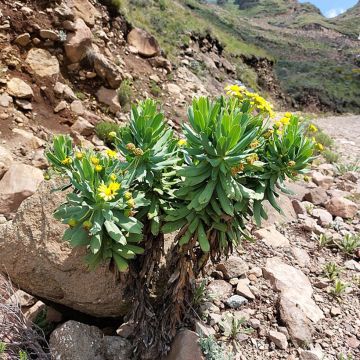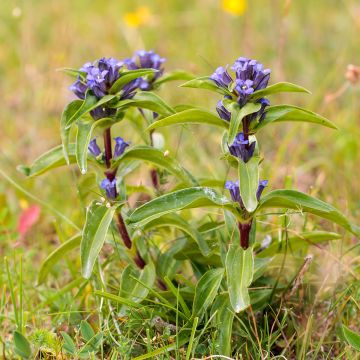

Euryops pectinatus - Euryops pectiné


Euryops pectinatus - Euryops pectiné


Euryops pectinatus - Euryops pectiné


Euryops pectinatus - Euryops pectiné
Euryops pectinatus
Euryops pectinatus
Grey-leaved Euryops, Golden Daisy Bush
Unfortunately, the plants arrived in a poor condition; I hope they will recover in a few weeks. This is the first time I have received plants in such a state.
Thierry , 11/03/2024
Special offer!
Receive a €20 voucher for any order over €90 (excluding delivery costs, credit notes, and plastic-free options)!
1- Add your favorite plants to your cart.
2- Once you have reached €90, confirm your order (you can even choose the delivery date!).
3- As soon as your order is shipped, you will receive an email containing your voucher code, valid for 3 months (90 days).
Your voucher is unique and can only be used once, for any order with a minimum value of €20, excluding delivery costs.
Can be combined with other current offers, non-divisible and non-refundable.
Home or relay delivery (depending on size and destination)
Schedule delivery date,
and select date in basket
This plant carries a 12 months recovery warranty
More information
We guarantee the quality of our plants for a full growing cycle, and will replace at our expense any plant that fails to recover under normal climatic and planting conditions.

Would this plant suit my garden?
Set up your Plantfit profile →
Description
The Euryops pectinatus, also known as Euryops ligulate or Golden Euryops, is a savannah daisy, a perennial bush close to Euryops chrysanthemoides. It quickly forms a beautiful 1-metre (3 feet) bush covered with elegant, deeply cut foliage of a beautiful grey-green hue, persisting in very mild climates. Its vegetation is almost hidden under a multitude of bright yellow daisies in spring and autumn, with flowering being almost uninterrupted from January to December if the plant is kept frost-free. This ornamental plant is superb in a large pot on the terrace but also in the garden, cultivated as an annual or perennial plant, depending on the region.
The Euryops pectinatus, also known as Othonna pectinata, is a short-lived perennial shrub of the asteraceae family, just like sunflowers and chrysanthemums. It is a botanical species native to the southwest of the Cape Province in South Africa. This botanical species often grows anchored on sandstone slopes and in ravines, on rocky soil. The plant is composed of a single stem branching near the base, forming a bushy shrub with a rounded habit, averaging 1 to 1.2 metres (3 to 4 feet) in height. Its growth is rapid, with the plant reaching its adult size in 3 years. The foliage, evergreen in mild climates, consists of flexible leaves, measuring 4 to 10 cm (2 to 4in) long, finely cut into irregular teeth (pectinatus means comb-shaped), with a slightly glaucous green colour with silvery reflections. The flowering takes place, depending on the climate, from February to November or even December if there is no frost, with a peak in May-June and then in September-October. The flowers are solitary heads measuring 5 cm (2in) in diameter, carried by long whitish petioles. They are composed of a row of lemon yellow ligules surrounding a golden yellow centre that turns brown. They are followed by the formation of easily self-seeding seeds in light soil. This Euryops, a coastal plant, fears the occasional heatwaves that occur inland: it should be placed in the shade in a cooler environment during very hot and dry weather.
Euryops plants are easy to grow in mild climates, extremely generous, and should be pruned more or less short at the end of each flowering period: many new shoots emerge from the stems, even lignified ones! Plant Euryops, Helianthus, and Senecio (cineraria, grandiflorus, vira-vira) in a coastal garden, as they withstand wind and spray perfectly, tolerate drought, and appreciate both rocky, slightly calcareous soils (predominant along our Mediterranean coasts) and sandy, humus-rich soils, more common along the Atlantic coast of our country. They are beautiful and undemanding flowering bushes, generally characterized by very beautiful evergreen foliage and/or generous flowering, which make a statement in the garden and are admired by visitors. They can also be combined with myrtles, cistus, Leptospermum, Grevillea, Melaleuca, Callistemons, and Galvezia speciosa in large, evergreen and flowering beds for a good part of spring and summer. They also thrive in large pots on a well-sheltered terrace or balcony. Gardeners in more continental regions, where winters are harsh and humid, should bring them indoors to a slightly heated greenhouse.
Report an error about the product description
Euryops pectinatus in pictures






Flowering
Foliage
Plant habit
Botanical data
Euryops
pectinatus
Asteraceae
Grey-leaved Euryops, Golden Daisy Bush
South Africa
Other Euryops - African Bush Daisy
View all →Planting and care
Plant Euryops pectinatus in open ground or in pots, in spring or autumn, depending on the mildness of your climate. Planting in early autumn is preferable in hotter and drier climates in summer. Install it in ordinary, well-loosened, sandy, rocky or humiferous soil, even rocky, slightly moist to rather dry in summer, not too rich, but imperatively well-drained. This plant tolerates the presence of limestone in the soil quite well, but it does not tolerate heavy and waterlogged soils in winter, which are detrimental to its hardiness. It will easily regrow from the stump in spring if the aboveground parts have been affected by frost, down to -5°C (23°F). A good protection such as winter frost cloth is necessary in the garden beyond this temperature. Summer drought is not a problem once Euryops is well established, but occasional watering will promote flowering. Euryops pectinate dreads heatwaves, which sometimes occur inland. It much prefers climates naturally tempered by the proximity of the sea. It tolerates sea spray well and thrives in sunny or partially shaded exposure. Regularly remove faded flowers and do not hesitate to prune after each wave of flowering: new shoots will even emerge from lignified stems ones.
Cultivation in pots: prepare a mixture of garden soil, perlite, leaf compost and coarse sand. Fill a pot with a diameter of 30 to 50 cm (12 to 20in), the bottom of which will be filled with a thick drainage layer composed of clay pellets, pumice or shards of terracotta. Follow regularwatering in summer and apply slow-release fertilier in spring. Repot every 2 years in a slightly larger container. Store the plant frost-free in winter and reduce watering.
Multiplication by propagation by cuttings of stems after flowering, or by sowing, to be done from time to time to regenerate the plant, which has a short lifespan.
Pests and diseases: this plant dreads waterlogged and poorly drained soils. There are no specific diseases known to affect it in our climates.
Planting period
Intended location
Care
-
, onOrder confirmed
Reply from on Promesse de fleurs
Similar products
Haven't found what you were looking for?
Hardiness is the lowest winter temperature a plant can endure without suffering serious damage or even dying. However, hardiness is affected by location (a sheltered area, such as a patio), protection (winter cover) and soil type (hardiness is improved by well-drained soil).

Photo Sharing Terms & Conditions
In order to encourage gardeners to interact and share their experiences, Promesse de fleurs offers various media enabling content to be uploaded onto its Site - in particular via the ‘Photo sharing’ module.
The User agrees to refrain from:
- Posting any content that is illegal, prejudicial, insulting, racist, inciteful to hatred, revisionist, contrary to public decency, that infringes on privacy or on the privacy rights of third parties, in particular the publicity rights of persons and goods, intellectual property rights, or the right to privacy.
- Submitting content on behalf of a third party;
- Impersonate the identity of a third party and/or publish any personal information about a third party;
In general, the User undertakes to refrain from any unethical behaviour.
All Content (in particular text, comments, files, images, photos, videos, creative works, etc.), which may be subject to property or intellectual property rights, image or other private rights, shall remain the property of the User, subject to the limited rights granted by the terms of the licence granted by Promesse de fleurs as stated below. Users are at liberty to publish or not to publish such Content on the Site, notably via the ‘Photo Sharing’ facility, and accept that this Content shall be made public and freely accessible, notably on the Internet.
Users further acknowledge, undertake to have ,and guarantee that they hold all necessary rights and permissions to publish such material on the Site, in particular with regard to the legislation in force pertaining to any privacy, property, intellectual property, image, or contractual rights, or rights of any other nature. By publishing such Content on the Site, Users acknowledge accepting full liability as publishers of the Content within the meaning of the law, and grant Promesse de fleurs, free of charge, an inclusive, worldwide licence for the said Content for the entire duration of its publication, including all reproduction, representation, up/downloading, displaying, performing, transmission, and storage rights.
Users also grant permission for their name to be linked to the Content and accept that this link may not always be made available.
By engaging in posting material, Users consent to their Content becoming automatically accessible on the Internet, in particular on other sites and/or blogs and/or web pages of the Promesse de fleurs site, including in particular social pages and the Promesse de fleurs catalogue.
Users may secure the removal of entrusted content free of charge by issuing a simple request via our contact form.
The flowering period indicated on our website applies to countries and regions located in USDA zone 8 (France, the United Kingdom, Ireland, the Netherlands, etc.)
It will vary according to where you live:
- In zones 9 to 10 (Italy, Spain, Greece, etc.), flowering will occur about 2 to 4 weeks earlier.
- In zones 6 to 7 (Germany, Poland, Slovenia, and lower mountainous regions), flowering will be delayed by 2 to 3 weeks.
- In zone 5 (Central Europe, Scandinavia), blooming will be delayed by 3 to 5 weeks.
In temperate climates, pruning of spring-flowering shrubs (forsythia, spireas, etc.) should be done just after flowering.
Pruning of summer-flowering shrubs (Indian Lilac, Perovskia, etc.) can be done in winter or spring.
In cold regions as well as with frost-sensitive plants, avoid pruning too early when severe frosts may still occur.
The planting period indicated on our website applies to countries and regions located in USDA zone 8 (France, United Kingdom, Ireland, Netherlands).
It will vary according to where you live:
- In Mediterranean zones (Marseille, Madrid, Milan, etc.), autumn and winter are the best planting periods.
- In continental zones (Strasbourg, Munich, Vienna, etc.), delay planting by 2 to 3 weeks in spring and bring it forward by 2 to 4 weeks in autumn.
- In mountainous regions (the Alps, Pyrenees, Carpathians, etc.), it is best to plant in late spring (May-June) or late summer (August-September).
The harvesting period indicated on our website applies to countries and regions in USDA zone 8 (France, England, Ireland, the Netherlands).
In colder areas (Scandinavia, Poland, Austria...) fruit and vegetable harvests are likely to be delayed by 3-4 weeks.
In warmer areas (Italy, Spain, Greece, etc.), harvesting will probably take place earlier, depending on weather conditions.
The sowing periods indicated on our website apply to countries and regions within USDA Zone 8 (France, UK, Ireland, Netherlands).
In colder areas (Scandinavia, Poland, Austria...), delay any outdoor sowing by 3-4 weeks, or sow under glass.
In warmer climes (Italy, Spain, Greece, etc.), bring outdoor sowing forward by a few weeks.













































